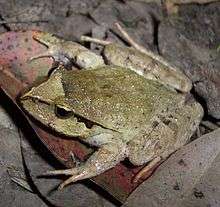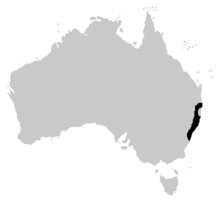Fletcher's frog
Fletcher's frog or sandpaper frog (Lechriodus fletcheri) is a species of ground frog native to eastern Australia from South-east QLD to Ourimbah, NSW. It inhabits rainforest and wet sclerophyll forest of the coast and ranges.
| Fletcher's frog | |
|---|---|
 | |
| Scientific classification | |
| Kingdom: | Animalia |
| Phylum: | Chordata |
| Class: | Amphibia |
| Order: | Anura |
| Family: | Limnodynastidae |
| Genus: | Lechriodus |
| Species: | L. fletcheri |
| Binomial name | |
| Lechriodus fletcheri Boulenger, 1890 | |
 | |
| Range of the Fletcher's frog | |
- "Fletcher's frog" may also refer to the long-thumbed frog (Limnodynastes fletcheri)
Description
This is medium-sized frog, getting to about 50mm in length. It is brown on the dorsal surface, however can range from light tan to dark or red brown. Its skin is rough in texture and feels like sandpaper. There are raised skin folds that run down the frogs back and a distinct triangle of lighter brown on the frogs head (between the eyes and snout). There is a dark line that starts at the nostril, extends through the eye and curves around the tympanum. There are crossbands on the legs, this may cause confusion with similar looking Mixophyes frogs. The toes and fingers are both free of webbing.
Ecology and behaviour

This species inhabits rainforest and wet sclerophyll forest. It is very active after heavy rains in summer and is rarely seen in drier conditions. Males make a short gar-r-r-up call from leaf litter around temporary pools and small streams. Up to 650 eggs are laid in a foamy mass and tadpoles are notoriously cannibalistic.
These frogs camouflage very well with leaf litter and can be very difficult to find if they are not active.
Sources
- Frogs Australia Network-frog call available here.
- Anstis, M. 2002. Tadpoles of South-eastern Australia. Reed New Holland: Sydney.
References
- Lemckert; et al. (2004). "Lechriodus fletcheri". IUCN Red List of Threatened Species. 2004. Retrieved 6 May 2006.CS1 maint: ref=harv (link) Database entry includes a range map and a brief justification of why this species is of least concern.
